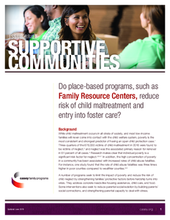Background
While child maltreatment occurs in all strata of society, and most low-income families will never come into contact with the child welfare system, poverty is the most consistent and strongest predictor of having an open child protection case. Three-quarters of the 676,000 victims of child maltreatment in 2016 were found to be victims of neglect, and neglect was the associated primary reason for removal in 61 percent of all cases. Research makes clear that individual poverty is a significant risk factor for neglect. In addition, the high concentration of poverty in a community has been associated with increased rates of child abuse fatalities. For instance, one study found that the rate of child abuse fatalities was three times higher in poor counties compared to wealthier counties.
A number of programs seek to limit the impact of poverty and reduce the risk of child neglect by strengthening families’ protective factors before hardship turns into crisis. They address concrete needs like housing assistance, child care, and food. Some interventions also seek to reduce parental social isolation by building parents’ social connections, and strengthening parental capacity to deal with stress.
Given that poor families often live in communities with few if any resources and services, place-based programs can be an effective way of offering individual and community services that mitigate the risk of child maltreatment and serious injury. One strategy for providing community-based family support has been the development of family resource centers. This issue brief addresses the following questions:
- What are family resource centers?
- What are the defining characteristics of a family resource center?
- What do we know about the effectiveness of family resource centers in reducing child welfare involvement?
- What is the return on investment?
- What is missing from the research literature?

